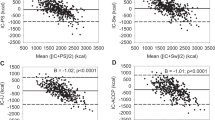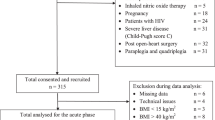Abstract
Objective: To determine current methods used by dietitians for estimating the energy requirement of a chronically and acutely ill adult patient and the variation in the application of methods.
Design: A cross-sectional survey including a case study.
Setting: Acute care adult hospitals in Australia.
Subjects: A total of 307 dietitians (66.2% response rate).
Interventions: Surveys were posted to hospitals. A reminder letter was sent to all hospitals 2 weeks after the initial posting and a follow-up survey was sent 6 weeks after the initial posting to non-respondents.
Results: Respondents calculated a mean energy requirement for the case study of 9780±1410 kJ/day. One-third of respondents calculated energy requirement within ±500 kJ of the mean. Respondents primarily used the Schofield equations (67.4%) followed by the Harris–Benedict equations (25.9%) to estimate energy requirement. Estimates using the Schofield equations calculated the highest mean energy requirement. The median injury factor used in the calculations was 1.3 (1.0–1.5). The values and reasons for the selection of injury factors varied widely. Calculated energy requirement did not differ with the aims of nutritional care—maintaining current weight (9700±1370 kJ/day) or increasing weight (9790±1380 kJ/day).
Conclusion: There was considerable variation in the methods and factors used for estimating energy requirement, resulting in a wide range of calculated requirements. The application of prediction methods to individuals in acute care does not appear to be universally understood among dietitians. Dietitians require an understanding of the correct application, appropriate use, and limitations of these prediction methods.
This is a preview of subscription content, access via your institution
Access options
Subscribe to this journal
Receive 12 print issues and online access
$259.00 per year
only $21.58 per issue
Buy this article
- Purchase on Springer Link
- Instant access to full article PDF
Prices may be subject to local taxes which are calculated during checkout
Similar content being viewed by others
References
Ahmad A, Duerksen DR, Munroe S & Bistrian BR (1999): An evaluation of resting energy expenditure in hospitalized, severely underweight patients. Nutrition 15, 384–388.
Case KO, Brahler CJ & Heiss C (1997): Resting energy expenditures in Asian women measured by indirect calorimetry are lower than expenditures calculated from prediction equations. J. Am. Diet. Assoc. 97, 1288–1292.
Coss-Bu JA, Jefferson LS, Walding D, David Y, Smith EO & Klish WJ (1998): Resting energy expenditure in children in a pediatric intensive care unit: comparison of Harris–Benedict and Talbot predictions with indirect calorimetry values. Am. J. Clin. Nutr. 67, 74–80.
Daly JM, Heymsfield SB, Head CA, Harvey LP, Nixon DW, Katzeff H & Grossman GD (1985): Human energy requirements: overestimation by widely used prediction equation. Am. J. Clin. Nutr. 42, 1170–1174.
Elia M (1990): Artificial nutritional support. Med. Int. 82, 3392–3396.
FAO/WHO/UNU (1985): Energy and Protein Requirements. Geneva: World Health Organisation.
Flancbaum L, Choban PS, Sambucco S, Verducci J & Burge JC (1999): Comparison of indirect calorimetry, the Fick method, and prediction equations in estimating the energy requirements of critically ill patients. Am. J. Clin. Nutr. 69, 461–466.
Foster GD, Wadden TA, Mullen JL, Stunkard AJ, Wang J, Feurer ID, Pierson RN, Yang MU, Presta E & Van Itallie TB (1988): Resting energy expenditure, body composition, and excess weight in the obese. Metabolism 37, 467–472.
Gibney ER (2000): Energy expenditure in disease: time to revisit? Proc. Nutr. Soc. 59, 199–207.
Halpern SL (1987): Quick Reference to Clinical Nutrition: A Guide for Physicians. Philadelphia: J.B. Lippincott Company.
Harris JA & Benedict FG (1919): A Biometric Study of Basal Metabolism in Man. Washington DC: Carnegie Institution of Washington.
Hunter DC, Jaksic T, Lewis D, Benotti PN, Blackburn GL & Bistrian BR (1988): Resting energy expenditure in the critically ill: estimations versus measurement. Br. J. Surg. 75, 875–878.
Jackson CJ & Furnham A (2000): Designing and Analysing Questionnaires and Surveys: a Manual for Health Professionals and Administrators. London: Whurr Publishers Ltd.
Jequier E & Schutz Y (1983): Long-term measurements of energy expenditure in humans using a respiration chamber. Am. J. Clin. Nutr. 38, 989–998.
Long CL, Schaffel N, Geiger JW, Schiller WR & Blakemore WS (1979): Metabolic response to injury and illness: estimation of energy and protein needs from indirect calorimetry and nitrogen balance. J. Parenter. Enteral Nutr. 3, 452–456.
Mifflin MD, St Jeor ST, Hill LA, Scott BJ, Daugherty SA & Koh YO (1990): A new predictive equation for resting energy expenditure in healthy individuals. Am. J. Clin. Nutr. 51, 241–247.
Ottery FD (1996): Definition of standardized nutritional assessment and interventional pathways in oncology. Nutrition 12, S15–S19.
Owen OE, Holup JL, D'Alessio DA, Craig ES, Polansky M, Smalley KJ, Kavle EC, Bushman MC, Owen LR & Mozzoli MA (1987): A reappraisal of the caloric requirements of men. Am. J. Clin. Nutr. 46, 875–885.
Owen OE, Kavle E, Owen RS, Polansky M, Caprio S, Mozzoli MA, Kendrick ZV, Bushman MC & Boden G (1986): A reappraisal of caloric requirements in healthy women. Am. J. Clin. Nutr. 44, 1–19.
Reeves MM & Capra S (2003): Predicting energy requirements: are current methods evidence based? Nutr. Rev. (in press).
Roza AM & Shizgal HM (1984): The Harris Benedict equation reevaluated: resting energy requirements and the body cell mass. Am. J. Clin. Nutr. 40, 168–182.
Schofield WN (1985): Predicting basal metabolic rate, new standards and review of previous work. Hum. Nutr. Clin. Nutr. 39, 5–41.
Soares MJ, Sheela ML, Kurpad AV, Kulkarni RN & Shetty PS (1989): The influence of different methods on basal metabolic rate measurements in human subjects. Am. J. Clin. Nutr. 50, 731–736.
The Australian Hospitals Directory (2000). North Sydney: ATA Professional Services Pty Ltd.
Vinken AG, Bathalon GP, Sawaya AL, Dallal GE, Tucker KL & Roberts SB (1999): Equations for predicting the energy requirements of healthy adults aged 18–81 y. Am. J. Clin. Nutr. 69, 920–926.
Warwick PM (1989): Predicting food energy requirements from estimates of energy expenditure. Austral. J. Nutr. Diet. 46, S3–S28.
White MS (1998): The calculation of the energy requirement of a critically ill child: a dietitian's survey. Austral. J. Nutr. Diet. 55, 82–86.
Wilmore DW (1977): The Metabolic Management of the Critically Ill. New York: Plenum Publishing Corporation.
Acknowledgements
We thank all the respondents who willingly completed the surveys.
Author information
Authors and Affiliations
Corresponding author
Rights and permissions
About this article
Cite this article
Reeves, M., Capra, S. Variation in the application of methods used for predicting energy requirements in acutely ill adult patients: a survey of practice. Eur J Clin Nutr 57, 1530–1535 (2003). https://doi.org/10.1038/sj.ejcn.1601721
Received:
Revised:
Accepted:
Published:
Issue Date:
DOI: https://doi.org/10.1038/sj.ejcn.1601721
Keywords
This article is cited by
-
Comparison of estimated energy requirements using predictive equations with total energy expenditure measured by the doubly labelled water method in acute spinal cord injury
Spinal Cord (2019)
-
Key determinants of energy expenditure in cancer and implications for clinical practice
European Journal of Clinical Nutrition (2016)
-
Estimating energy requirements in hospitalised underweight and obese patients requiring nutritional support: a survey of dietetic practice in the United Kingdom
European Journal of Clinical Nutrition (2012)
-
Calorimetry in obese women: comparison of two different operating indirect calorimeters together with the predictive equation of Harris and Benedict
Mediterranean Journal of Nutrition and Metabolism (2011)
-
Estimating resting energy expenditure in patients requiring nutritional support: a survey of dietetic practice
European Journal of Clinical Nutrition (2008)



